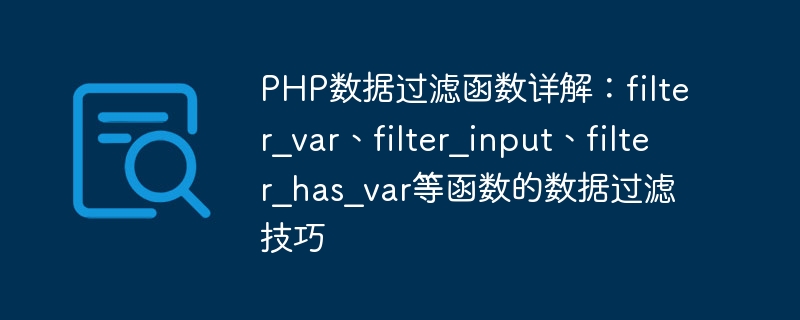

Detailed explanation of PHP data filtering functions: data filtering skills for filter_var, filter_input, filter_has_var and other functions, specific code examples are required
In Web development, data filtering is very important of a link. Filtering user-entered data protects our applications from potential security threats. PHP provides a series of powerful data filtering functions. This article will introduce the filter_var, filter_input and filter_has_var functions in detail, and give some practical code examples.
filter_var function is used to filter the given variable. It accepts two parameters: the variable to filter and the filter options. Filter options can be predefined constants or custom filters.
Here is an example of using the filter_var function to filter email:
$email = $_POST['email'];
if (filter_var($email, FILTER_VALIDATE_EMAIL)) {
echo "邮箱地址有效";
} else {
echo "邮箱地址无效";
}In the above example, we get the email address entered by the user from the form. Then use the filter_var function to use the email address as the variable to be filtered, and use the FILTER_VALIDATE_EMAIL filter option to filter. If the email address is valid, "Email address is valid" is output; otherwise, "Email address is invalid" is output.
The filter_input function is used to obtain input from a specific input source and filter it. It accepts three parameters: input source, input variable name, and filter options.
Here is an example of filtering a URL using the filter_input function:
$url = filter_input(INPUT_GET, 'url', FILTER_SANITIZE_URL);
if ($url !== false) {
echo "过滤后的URL:" . $url;
} else {
echo "无效的URL";
}In the above example, we use the filter_input function to get the input named "url" from the GET request and use FILTER_SANITIZE_URL Filter options to filter it. If the filtered URL is valid, output "Filtered URL:" and the filtered URL; otherwise, output "Invalid URL".
The filter_has_var function is used to check whether the specified input variable exists in a specific input source. It accepts two parameters: the input source to check and the input variable to check.
The following is an example of using the filter_has_var function to check whether an input variable named "name" exists in a POST request:
if (filter_has_var(INPUT_POST, "name")) {
echo 'POST 请求中存在名为 "name" 的输入变量';
} else {
echo 'POST 请求中不存在名为 "name" 的输入变量';
}In the above example, we use the filter_has_var function to check a POST Whether there is an input variable named "name" in the request. If it exists, output "The input variable named 'name' exists in the POST request"; otherwise, output "The input variable named 'name' does not exist in the POST request".
By using these data filtering functions, we can process user-entered data more safely. However, it should be noted that these filter functions do not replace other security measures, such as data validation, parameter binding, and prepared statements. Therefore, during the development process, we should comprehensively use various security measures to ensure the security of the application.
Summary:
This article introduces the data filtering functions in PHP in detail: filter_var, filter_input and filter_has_var. These functions can help us effectively filter user-entered data, thereby improving application security. When using these functions, we need to understand the role of each filter and select the appropriate filter based on the actual situation. In addition, it should be noted that these filtering functions cannot completely replace other security measures. Developers should comprehensively use various security methods during the development process to ensure the security of the application.
The above is the detailed content of Detailed explanation of PHP data filtering functions: data filtering skills for filter_var, filter_input, filter_has_var and other functions. For more information, please follow other related articles on the PHP Chinese website!




